Source: Monthly Outlook: The Great Ethereum vs Solana Debate
Author: David Duong, CFA - Global Head of Research
Translation: Lenaxin, ChainCatcher
ChainCatcher Editor's Summary
This article is compiled from Coinbase's latest monthly outlook research report. The report points out that as the crypto market gradually warms up, institutional investors' focus is shifting from Bitcoin to other crypto assets such as Ethereum and Solana. Despite the increased attention, the price trends of Ethereum and Solana in the short term will still be more influenced by technical factors.
Summary
Institutional funds continue to flow into the BTC market, with Bitcoin currently accounting for 63% of the total cryptocurrency market capitalization. However, recent market attention is turning to mainstream tokens like ETH and SOL, which show valuation advantages against the backdrop of Bitcoin reaching all-time highs.
- Key factors influencing next quarter's market include:
Progress of the SEC's approval of spot ETFs.
The possibility of including staking features in ETF products.
Continued entry of institutional funds.
- It is worth noting that there has long been a tendency in the crypto community to compare ETH and Solana in opposition, but in fact, their technical routes and investment logic are showing differentiated development, allowing for parallel market space.
The current crypto community generally simplifies the competition between Ethereum and Solana into a "choose one" proposition, but in reality, the technical architecture and investment logic of both are showing differentiated development, with the potential for parallel growth.
For example, institutional participants are increasingly using ETH as a proxy for a larger real-world asset (RWA) theme—covering a broader range of areas such as stablecoins, payments, and tokenization.
Solana's investment philosophy focuses on its network's advantages in speed, user engagement, and revenue generation compared to competitors. While its activity is primarily concentrated on memecoin trading, it has also gained attention in other areas.
In the short term (Q3 2025), against the backdrop of an overall improving market, the market momentum of these two tokens will be more driven by technical factors (i.e., supply and demand) rather than fundamentals, and the substantial impact of network technology upgrades may be relatively limited.
False Dichotomy
The technical route dispute between Ethereum (ETH) and Solana (SOL) has long influenced institutional investors' valuation of blockchain platforms. Market opinions are clearly divided: traditional institutional investors generally value Ethereum's security and decentralization, making it an important infrastructure in the field of real-world asset (RWA) tokenization; while supporters argue that Solana has a competitive advantage due to its higher transaction speed and lower costs. As Ethereum's layer 2 scaling solutions (L2) continue to develop, this technical discussion is becoming more complex.
Table 1. Comparison of Ethereum and Solana Network Metrics
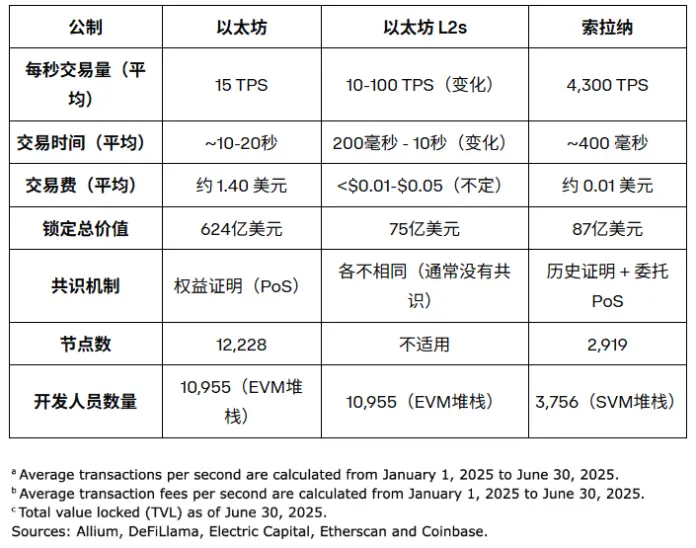 These arguments represent a false dichotomy, not because the differences between the technologies are not real or important, but because the reasons for engaging with ETH, SOL, or both at any given time are more sensitive to market conditions.
These arguments represent a false dichotomy, not because the differences between the technologies are not real or important, but because the reasons for engaging with ETH, SOL, or both at any given time are more sensitive to market conditions.
When Will Altcoin Season Arrive?
A significant difference between the current cryptocurrency cycle and previous cycles is the absence of an altcoin season. Data shows that over the past year, many retail investors have suffered heavy losses trading meme coins and long-tail altcoins, leading to a lack of funds or a strong wait-and-see sentiment. In this context, although some altcoins have recently outperformed ETH and SOL, price trends still lead many institutional investors to prefer holding large-cap stocks.
Turning Point for ETH
In early May, the ETH market experienced a large-scale short squeeze, with liquidation volumes significantly rising. Figure 1 shows that in May, approximately $897 million (374,000 ETH) of ETH shorts were liquidated, compared to $575 million in April and $467 million in March. This triggered a technical-driven surge, highlighting a large number of over-leveraged positions in ETH, leading to short covering and subsequent replenishment. As a result, this also began to limit ETH's ability to act as a financing currency against long-tail altcoins, a strategy many market participants had adopted over the past 12-18 months.
Figure 1. ETH Short Futures Liquidation Volume Increased in May
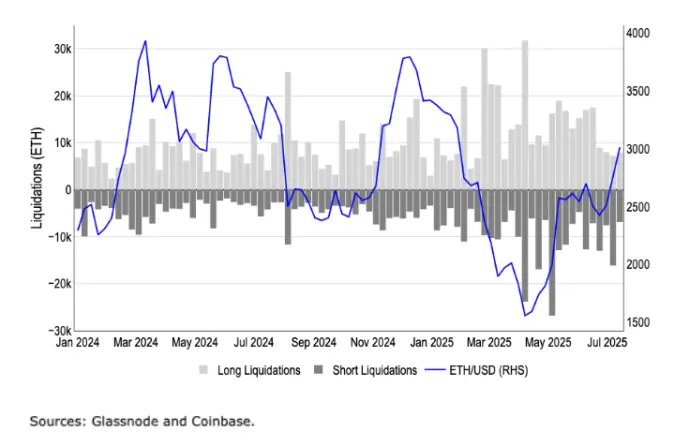
In fact, ETH's beta coefficient relative to the cryptocurrency market (represented by the COIN50 index of the top 50 cryptocurrencies by market capitalization) rebounded to around 1 in mid-June. (ETH's beta coefficient fell to 0.92 in July, although still higher than SOL's 0.81 and BTC's 0.32). In other words, ETH's returns are currently in sync with the overall cryptocurrency market performance. See Figure 2. Therefore, this makes ETH an attractive choice for a barbell strategy to hedge against tokens further out on the risk curve, as these ETH long positions can help anchor those with higher risk exposure and asymmetric upside potential.
Figure 2. ETH's Beta Coefficient Relative to the Cryptocurrency Market is Very Close to 1
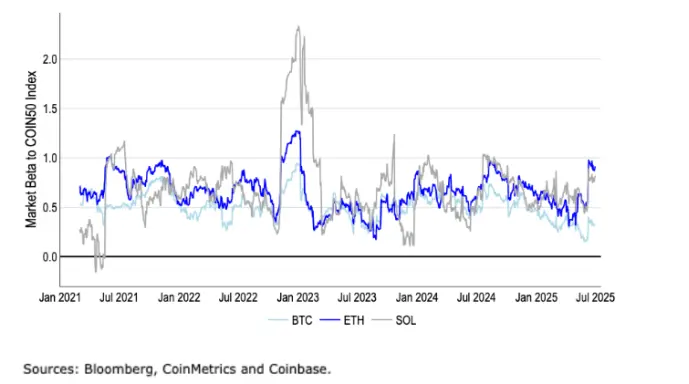
Meanwhile, proposed upgrades such as EIP-9698 (increasing Ethereum's gas limit from 36 million to 3.6 billion) and EIP-7983 (limiting the maximum gas amount per transaction) have limited effects on ETH's performance improvement. These technical improvements primarily focus on increasing transaction throughput and block execution efficiency. A more significant change in the current market is the growing interest of institutional investors in tokenized stocks and risk-weighted assets (RWA), with related infrastructure tokens gaining more funding attention as investors speculate on the platforms that may exist for these assets.
Figure 3. Stablecoin Network Transfer Volume (USD)
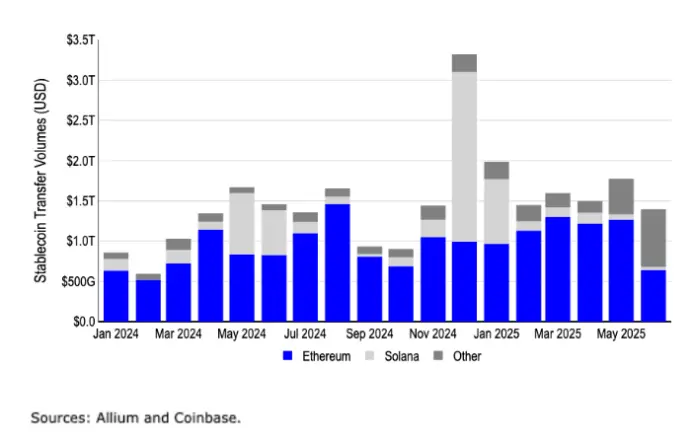
Solana Ecosystem Expansion
On the other hand, Dune Analytics shows that since the end of Q2 2024, Ethereum's share of on-chain activity has been continuously declining, while Solana currently occupies 44% of total blockchain activity. Figure 4 displays this index data, which tracks the comprehensive adoption of the blockchain, combining three key metrics: transaction fees (weight 45%), USD transfer volume (weight 45%), and transaction count (weight 10%). The higher weight of fees and transfers reflects more meaningful activity compared to transaction counts. This trend indicates a fundamental shift in blockchain adoption patterns over the past year.
Figure 4. Comprehensive View of On-Chain Adoption
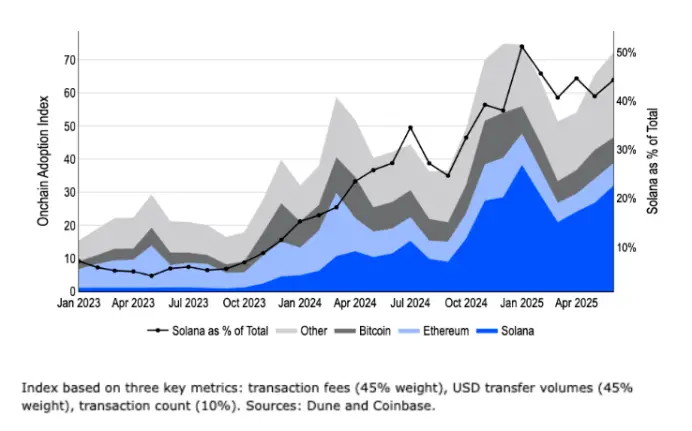
Solana's network activity is primarily driven by memecoin trading, especially since the launch of pump.fun in January 2024, which has become a major driver of Solana's expansion. The challenge for Solana is that interest in memecoins may peak in early 2025, with data showing that over 60% of mature memecoin projects originate from the letsBONK.fun platform. Market observations indicate that the memecoin trading frenzy may peak in early 2025, but it is expected to maintain a certain level of market activity. With events like the July 12 launch of the PUMP token, investors can participate in the memecoin market through various channels, no longer limited to simply going long on SOL tokens.
Nevertheless, testing Solana's ability to manage massive transaction volumes in practice may enable it to achieve product-market fit in other areas of the growing crypto ecosystem. In fact, Solana recently launched the Solana Attestation Service as a KYC/AML layer to serve capital market opportunities. The Solana Foundation also released a white paper in May titled "Tokenized Stocks on Solana: A New Paradigm for Capital Markets," further clarifying its direction in the digitalization of traditional financial assets.
Figure 5. Comparison of "Graduated" Tokens and Active Addresses
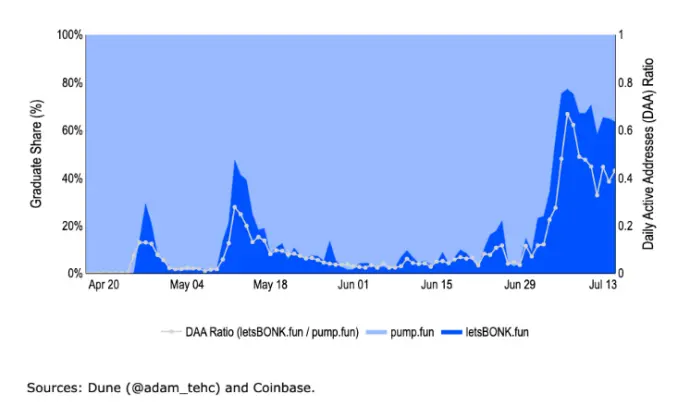
However, for now, the price of SOL will be more driven by technical factors, such as the growing demand for enterprise fund management tools and the inflow of funds from the US spot SOL ETF, with regulatory information indicating that these SOL ETFs may be approved as early as this quarter. (The REX-Osprey Solana + Staking ETF is not a product formally approved by the SEC, but the SEC has revealed a new framework that may shorten the approval time for future ETFs.) On the technical side, some meaningful upgrades may be on the horizon, such as Solana's Alpenglow proposal—a transformative upgrade that will replace the current consensus mechanism, accelerating consensus speed through local timers and off-chain voting mechanisms. This aims to improve network performance and reduce validator costs. However, market analysis indicates that the current price fluctuations of SOL have limited correlation with these technical upgrades.
Enterprise Demand
In 2025, corporate financial tools significantly increased their cryptocurrency holdings, adding over 825,000 ETH (valued at $3 billion as of July 18) and 2.95 million SOL ($531 million) among 14 specialized purchasing entities. See Figure 6. Additionally, many of these companies have committed to staking their ETH and SOL for yield, with some even locking their supply through DeFi integration, indicating a strategic shift from short-term trading to long-term asset allocation. In fact, the preference for ETH and SOL among these tools is partly due to their yield generation potential, which has been further amplified by media coverage of stablecoins and tokenized securities. According to previous monthly outlook reports, corporate balance sheets will remain a major driver of cryptocurrency market demand in the second half of 2025.
Figure 6. Top ETH and SOL Corporate Financial Tools
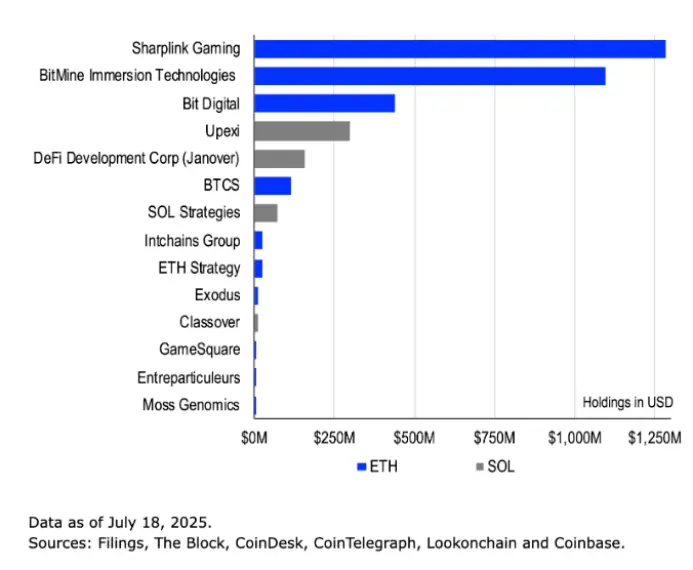
Conclusion
While institutional investors have favored BTC for most of this cycle, they are gradually shifting towards selected altcoins like ETH and SOL, which appear relatively undervalued. Benefiting from the passage of the GENIUS Act in Congress, ETH is increasingly seen as a representative of the burgeoning real-world asset theme. Nevertheless, both ETH and SOL have garnered interest from institutional investors, supported by their beta values relative to other cryptocurrency complexes. Although Solana has seen a slowdown in memecoin-driven activity, it is demonstrating its capacity for high transaction volumes and exploring new areas. In the short term, technical factors may dominate price trends, including capital flows and market sentiment indicators.
Disclaimer
The content of this article does not represent the views of ChainCatcher. The opinions, data, and conclusions in the text reflect the personal positions of the original author or interviewees, and the translation party maintains a neutral stance and does not endorse their accuracy. This does not constitute any professional advice or guidance, and readers should exercise caution based on independent judgment. This translation is for knowledge-sharing purposes only; readers are strictly advised to comply with the laws and regulations of their respective regions and not to engage in any illegal financial activities.
免责声明:本文章仅代表作者个人观点,不代表本平台的立场和观点。本文章仅供信息分享,不构成对任何人的任何投资建议。用户与作者之间的任何争议,与本平台无关。如网页中刊载的文章或图片涉及侵权,请提供相关的权利证明和身份证明发送邮件到support@aicoin.com,本平台相关工作人员将会进行核查。




